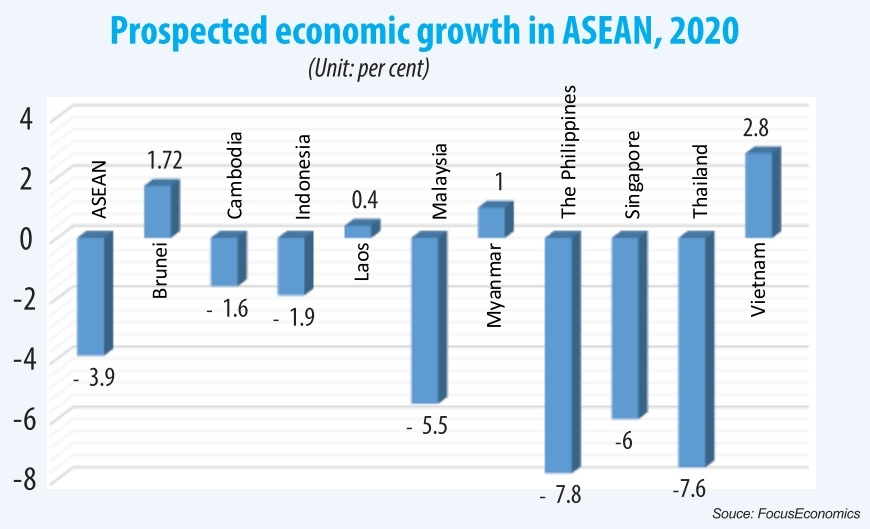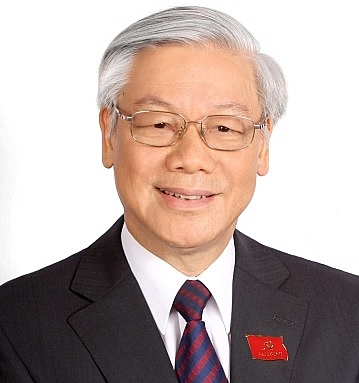Improving trade at heart of ASEAN goals
 |
All eyes were on the 37th ASEAN Summit and Related Summits organised last week online, with Vietnam acting as ASEAN chair, where a record number of over 80 documents and agreements were inked and adopted. Their prime target was to lift regional nations out of difficulties caused by the pandemic and facilitate the performance of regional businesses, as the backbone of economic growth.
The bloc last week established the ASEAN Regional Centre on Public Health Emergencies and Emerging Diseases, the ASEAN Regional Reserve of Medical Supplies, and the ASEAN Smart Logistics Network with its first project, the Vinh Phuc ICD Logistics Centre.
This venture, located in the northern province of Vinh Phuc, has been approved by the provincial People’s Committee and is now seeking investors. With an estimated total investment of $166.3 million, it is designed for a combined cargo capacity of 530,000 twenty-foot equivalent units.
The centre will act as a distribution hub and an inland clearance depot in a bid to provide logistics services and meet the market demand.
The bloc has also approved the ASEAN Comprehensive Recovery Framework, which guides the region into post-pandemic recovery actions, and will ensure benefits for the public, businesses, localities, and governments as all of them have been hit by COVID-19.
“The ASEAN Comprehensive Recovery Framework is mostly focused on combining and harmonising policies of member states, while other issues such as establishing shared funds or a regional reserve of medical supplies will need technical or financial contributions from regional nations or from outside,” Nguyen Quoc Dung, Vietnamese Deputy Minister of Foreign Affairs and head of the ASEAN Senior Officials’ Meeting, told VIR.
Regional leaders have also adopted plans to maintain production and supply chains, boost connectivity, and recover intra-bloc trade and investment activities.
“The plans are also aimed to create more favourable travelling for entrepreneurs and investors in the context of COVID-19. For the time being, we can consider the re-opening of the shared entry for ASEAN citizens at border gates,” stated Vietnamese Prime Minister Nguyen Xuan Phuc at last week’s opening ceremony of the 37th ASEAN Summit and Related Summits.
Regional nations last week signed an MoU on the implementation of non-tariff measures on essential goods, aiming to carry out the Hanoi Plan of Action on enhancing economic cooperation within ASEAN and connecting supply chains amidst the pandemic.
| Nguyen Phu Trong - Party General Secretary State President
It falls upon us to identify an optimal position for ASEAN in the post-pandemic world. The strong will and aspiration to uphold a region of peace, stability, cohesion, unity, and the rule of law should be further fostered as a core value of Southeast Asia and the ASEAN Community. ASEAN member states need to showcase their resilience and work together in realising recovery plans and initiatives via new, substantial, and effective ways of operation and collaboration, and frameworks for regional dialogue and cooperation should be fully harnessed. ASEAN can make even greater contributions to promoting multilateralism, upholding international law, and strengthening the global multilateral system with the United Nations at its core. It is Vietnam’s consistent policy to engage in diversification and multilateralisation of its external relations, to be a reliable friend and partner, and an active and responsible member of the international community. Guided by that policy, Vietnam has gone from strength to strength over the past 75 years. Such spirit shall further be the guiding compass for our foreign policy, all the more so as the global landscape evolves in such a complex and unpredictable manner. Vietnam’s ASEAN membership over the past 25 years has served as the cornerstone for its international integration and conducting of foreign affairs. It has become a common home, and the ASEAN Community is critical to upholding the Southeast Asian identity. As the 2020 chair, Vietnam has been promoting a cohesive and responsive ASEAN. We always value the solidarity, support, and assistance of fellow member states, partners, and friends of ASEAN. This reflects the spirit of the ASEAN Community in seeking to triumph over all adversities, maintain the momentum of integration, grow strong, and reinforce ASEAN centrality for a Southeast Asia of peace, friendship, neutrality, and stability. President Ho Chi Minh once said, “unity makes strength”. Only through cooperation, trust, and synergy can ASEAN and the world overcome hardships to revitalise growth and maintain sustainable development. |
Suitable frameworks
Luong Hoang Thai, director of the Department of Multilateral Trade Policy under the Vietnamese Ministry of Industry and Trade, said that one of the issues facing ASEAN is non-tariff barriers within the bloc.
The MoU will help deal with problems in the short term while setting forth a new framework to handle issues businesses could meet during the regional integration process.
According to Thai, the region’s economic ministers had agreed to initially add over 150 production lines in the MoU like pharmaceutical products and medical supplies, which will eventually be extended.
Under regional commitments, specifically the ASEAN Trade in Goods Agreement, Vietnam and regional nations have removed all tariffs, making it easier for the countries to boost trade cooperation.
“Fighting the pandemic successfully will mean more convenient facilitation of the trade and investment flows within ASEAN, and those from the region into Vietnam,” Deputy Minister Dung noted.
ASEAN is now Vietnam’s fourth-largest export market after the US, the EU, and China. Vietnam’s export turnover to the region surged from under $1 billion in 1995 to $24.7 billion in 2018 and $25.3 billion last year, up 1.9 per cent on-year. However, in the first 10 months of 2020, the figure hit $19 billion, down 11.6 per cent on-year.
Southeast Asia is also Vietnam’s third-largest import market. The country’s import turnover from other member states totalled $32 billion in 2018 and $32.1 billion last year. Due to the pandemic, the figure touched $24.4 billion in the first 10 months of 2020, down 8.5 per cent on-year.
As of October 20, Vietnam attracted about $81.87 billion in registered investment capital from ASEAN member states, including Singapore (over $55.72 billion), Thailand ($12.5 billion), Malaysia ($12.8 billion), Indonesia ($593.8 million), and the Philippines ($260.36 million).
Working in tandem
PM Phuc called for more concerted actions in the region to drive the bloc forward with higher economic growth to be created by higher production, business, and consumption.
“ASEAN needs to concentrate its resources and efforts into pushing back against COVID-19, creating vaccines and effective treatment methods, and improving the preventive medical capacity in order to meet medical emergencies, and protect lives,” he said. “We also need to boost measures to support businesses to recover production, and create jobs. The ASEAN Community councils must expedite the implementation of the ASEAN Comprehensive Recovery Framework and its action plan very soon.”
In a bid to contribute to reshaping the world post-pandemic, PM Phuc continued, ASEAN needs to further consolidate its position amid the shift of political-economic strength among nations, and amid the adjusted production chains around the globe. ASEAN’s existing competitive advantages need to be supplemented with values from advanced science and technology, digital transformation, high-quality human resources, and the ability to diversify input and output markets.
According to global analysts FocusEconomics, most regional economies are expected to suffer from negative growth this year (see chart).
Noting the massive difficulties facing the whole region, Dato Lim Jock Hoi, Secretary-General of ASEAN, stressed, “There has never been a more urgent time for ASEAN to fully realise the potential of its internal market. Removing tariff barriers or formal restrictions is not sufficient. We need to do more to keep the macroeconomy stable and maintain financial liquidity, tackle non-tariff barriers, ramp up trade and investment facilitation, and embrace digitalisation and dematerialisation of trade, to name a few.”
Hoi added that there have been recent positive movements, from all member states entering the ASEAN Single Window live environment to the recent operationalisation of the ASEAN-Wide Self Certification Scheme, but insisted more is needed.
According to him, the growth outlook for the region has been further revised downward, from initially a 1 per cent growth at the start of the pandemic, to a 2.7 per cent contraction, and now a 3.8 per cent contraction. Notwithstanding, there are early signs of recovery where economies have started to reopen, and the latest data has raised some hope that perhaps global trade is not being hit as badly as expected. While recovery is expected in 2021, it is foreseen to be an L-shaped rather than V-shaped recovery.
“Unless concerted efforts are made to address this, we will risk having millions fall back into poverty, seeing a reversal of progress made over the years, and permanent productivity and welfare loss,” Hoi stressed. “By leveraging on its collective competitiveness, ASEAN can be a stronger player in the broader regional economy. Upgrading existing free trade agreements and ensuring early entry into force of the Regional Economic Comprehensive Partnership should form part of the region’s recovery strategy.”
What the stars mean:
★ Poor ★ ★ Promising ★★★ Good ★★★★ Very good ★★★★★ Exceptional
 Tag:
Tag:
Themes: Drive ASEAN Forward
Related Contents
Latest News
More News
- Ho Chi Minh City hits $8.37 billion in FDI (December 29, 2025 | 08:28)
- Tax sector wraps up 2025 and sets priorities for next year (December 25, 2025 | 14:00)
- Heavy industries set for pilot greenhouse gas quotas (December 25, 2025 | 10:00)
- $250 million deal targets women-owned SMEs, sustainable agriculture (December 22, 2025 | 17:40)
- UOB sees Vietnam growth easing in fourth quarter (December 22, 2025 | 17:39)
- Government moves to establish International Financial Centre (December 21, 2025 | 21:00)
- Vietnam's IFC to target global investment flows (December 21, 2025 | 18:00)
- Ha Tinh breaks ground on major Vingroup industrial and energy projects (December 19, 2025 | 18:24)
- EVN launches major power infrastructure projects nationwide (December 19, 2025 | 18:17)
- VAL inaugurates second production line to meet domestic animal feed demand (December 19, 2025 | 16:37)
























 Mobile Version
Mobile Version